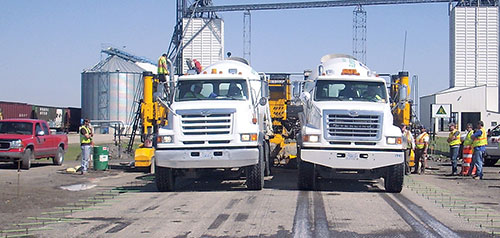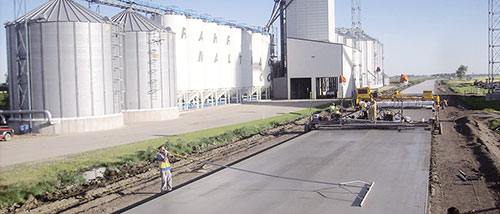GOMACO World Index --- GOMACO World 41.1 - October 2013
Best Rides Ever – North Dakota 200 Concrete Overlay Project Excels
Reprinted with permission from David Sethre and “RM Concrete Voice,” the publication of the North Dakota Ready Mix and Concrete Products Association.
Project Overview
This five inch (127 mm) and six inch (152 mm) overlay project was chosen as the top rated concrete pavement project in North Dakota in 2011 in all categories. The project also won the 2012 American Concrete Paving Association’s Gold Award for the Overlays-Highways category. A concrete pavement was chosen for this project due to the very high level of truck traffic generated by American Crystal Sugar and Rahr Malting industrial facilities located on the route. The tight construction schedule played into the strengths of the concrete overlay option.
The contractor achieved a ride smoothness noted to be the smoothest concrete pavement ever constructed in the state and possibly the nation; a 38.6 IRI before corrective action. Some contractors chose to not bid this project due to the very difficult ride standards. But, using the innovative GOMACO Smoothness Indicator (GSI®) mounted to the paver, the contractor was able to tune paver operations to achieve very smooth paving from the first hour of paving. Through this and other innovations, the contractor was able to meet the “localized roughness” standard of under 80 inches (2032 mm) per mile in a 25 foot (7.6 m) continuous segment, while the final corrective action grinds touched only nine different spots in the 5.5 mile (8.9 km) project.
Public information efforts by the design engineer created the best possible construction staging plan to keep road users happy. Project work was conducted under three individual staging units which kept traffic flowing to the high intensity industrial complexes. The staging plan was executed perfectly in spite of many planned leave-outs, hot weather and continuous rain. Paving operations requiring trucks to back down to the paver from one mile (1.6 km) away contributed to a most difficult paving coordination, especially when night operations were started. And, through effective planning for sustainability outcomes, almost the entire existing infrastructure was either recycled or reused in the final project to achieve a long life project. This project outcome proved the viability of the concrete overlay as a primary pavement tool for engineers at the North Dakota Department of Transportation (NDDOT). Because of the leadership and performance of Dakota Underground Construction Company to achieve the highest of goals for quality, scheduling and ride smoothness, many more opportunities to demonstrate the concrete solution using overlays will occur.
Innovative Construction
Innovative construction effort was critical to achieve the productivity and quality necessary for the project to succeed. From extreme efforts from the ready mix supplier to provide very uniform paving mixes to the non-glare lighting systems necessary for efficient night construction, innovation turned the project from a potential nightmare to a showcase effort in the construction of concrete overlays.
Features of the innovative construction process include:
1) Project Staging: The project was divided into three construction stages, keeping two segments open to traffic at all times. Segments had to have earthwork for widening, milling, surveys, replacement of centerline culverts, and be paved and open to traffic within the necessary time period, in order to meet project schedules.
2) Wet Weather: During the first half of maximum activity, a total of seven inches (178 mm) of rain on the project delayed work and forced earthwork activities to an extended halt. Yet, construction was completed early on the very tight timeline aided by the presence of a visual pavement for the overlay.
3) Night Paving: In order to maximize access to sufficient trucks and drivers, the ready-mix producer and the contractor agreed to do much of the paving activity at night. This provided many challenges, but many more benefits, including avoiding “heating of the sun” temperature limitations on the dark asphalt paving surface.
Project Phasing
The overlay was placed on two variations of base.
South End of Project: Shoulder material was removed from the outside of the old 22 foot (6.7 m) wide concrete pavement for the widening operations contiguous with the concrete overlay paving. Unforeseen deteriorated concrete pavement required significant concrete pavement restoration (CPR) before paving operations could commence. The six inch (152 mm) unbonded concrete overlay was placed on the reduced section of the asphalt covering the old concrete pavement. Where milling operations unintentionally removed all asphalt from the concrete, a fabric interlayer was used as a substitute for the asphalt debonding layer.
North End of Project: The remainder was constructed on a milled asphalt surface which removed heavy ruts and restored the surface contour of the old pavement. A total of 31,000 cubic yards (23,701 m3) of borrow was used to widen the roadway, a troublesome process during seemingly continuous rain conditions. After removing about four inches (102 mm) of asphalt, little repair of the old 10 inch (254 mm) asphalt was necessary prior to paving the overlay.
Dakota Underground used their GOMACO GP-2600 to slipform a smooth overlay and win an American Concrete Paving Association Gold Award on a project in North Dakota.
Concrete Batching and Hauling
Achieving superior ride performance with the use of ready mix was noted as a challenge from the very beginning. The ready-mix supplier was tasked with providing a very uniform mix from two batch plants located at the south end of the project. The contractor demanded no room for tolerance in slump of the mix, expecting a 1.25 inch (32 mm) slump from both plants.
Quality and process control of mixes on the project was, by default, controlled by the demand of the contractor for a very uniform mix as delivered to the paver. Mixes were established for high strength, durability and sustainability. The following were implemented:
1. Well graded aggregate gradations
2. Low water cement ratio: 0.40 at 564 pounds per cubic yard total cementitious
3. High-volume fly ash content: 30 percent direct replacement of cement
4. Use of durable local river aggregates
5. Use of a local ready-mix supplier and plant site for paving concrete
Based on the assurances of the ready-mix supplier to produce a very uniform mix, the contractor was able to avoid the necessity of permitting and construction of a separate plant site. The contractor tasked the ready-mix supplier to provide a mix that had an extreme level of optimization of aggregate for efficient paving plus the finishing capability which would minimize the need for finishers after the paver. The mix met all these requests, allowing the contractor to choose to remove straightedge/finisher personnel without impact to ride performance.
Production achieved 300 cubic yards (229 m3) per hour routinely. Production control was such that few trucks were rejected due to non-uniform slump. Uniform mix production contributed greatly to the very smooth ride outcome for the project, a very unique challenge for any ready-mix operation.
Paving the ND 200 Overlay
Dakota Underground brought in their GOMACO GP-2600 slipform paver for the overlay project. It paved the overlay 28 feet (8.5 m) wide. To achieve the extreme low IRI standard of 54 and Localized Roughness maximums of IRI = 80, the contractor purchased a GOMACO Smoothness Indicator (GSI®) for real-time monitoring of real-time pavement smoothness out of the paver. The GSI attached to the paver gave real-time output of bumps and dips in the surface, allowing immediate opportunities for tuning of paver operations for smooth ride.
This was extremely useful to tune paver vibrators and controls to achieve the smoothest possible output within minutes of the start of paving. The realtime monitoring allowed immediate adjustment of vibrator frequency and paver controls to calibrate the mix to the paver. This factor alone, allowed the paver to achieve maximum smoothness output to earn high levels of bonus for ride and avoid the costly requirement for grinding to meet spec.
Corrective Measures for Smoothness
A total of nine spots required grinding to meet the Localized Roughness standard, all at headers, wet track-line spin-outs, or the two nonuniform loads accidentally accepted. Paver output was superior while avoiding any corrective grinding to meet the IRI = 54 standard for the 528 foot (161 m) lots. After grinding the nine locations for the Localized Roughness standard, IRI for the project improved to 37.9. The contractor achieved 65 percent of available IRI ride incentives without significant grinding costs on a project with a very severe ride standard. Every lot met IRI = 54 spec limits.
Unique Solutions - Night Operations
To avoid driver hour limitation problems and to secure adequate trucks for continuous paving process, much of the project ended up being constructed at night. Ready-mix trucks were backed into place for side-by-side double dumping whenever possible. The difficulty of trucks meeting, one approaching the paver backing up, the other leaving the paver empty, was especially difficult in the dark with only 21 feet (6.4 m) of clearance on the road top. Backing trucks caused little disruption to fabric interlayers on the unbonded portion through careful steering operations.
The contractor was able to locate special balloon type non-glare lights for use at the paver. This was a critical success outcome, as the ability of a truck driver to safely back the concrete down the dark road towards the paver lights was critical for production. As the balloon lights cast few shadows, and provided lighting similar to a cloudy day, production was uninhibited. A parallel innovation in guiding the trucks included the use of glow sticks to mark the elevated shoulder tie bars at the edge of the pavement. After implementation of this unique system, few flat tires were experienced from driving into tie bars during side-by-side truck dumping operations.
Every worker involved near the paver during night operations was required to wear either a glow stick on the vest or a headlamp. The NDDOT Quality Assurance crews used a Polaris Ranger all-terrain vehicle to follow the paver in the mostly flooded ditches, keeping personnel out of the main construction zone. No accidents occurred during the entire project activity period.
Traffic Management
Due to the major industrial facilities located on the route, access for trucks and employees was necessary 24 hours a day. Staging of construction was established to keep some driveways open at all times, with necessary provision for alternate parking facilities at the industrial plants when main parking lots were affected by construction operations. When necessary, temporary driveways were constructed. Traffic was maintained to all farms and industrial facilities without complaint from locals, management or employees.
Railroad traffic was also maintained at all times at the American Crystal Sugar plant crossing. Extreme restrictions by the railroad at the American Crystal Sugar crossing were overcome without significant impact to the construction schedule and without accidents or incidents. Plus, the presence of a railroad crossing in the middle of the project was extremely difficult to manage for the delivery of concrete.
Summary
This project was an extreme success due to the effectiveness of the design engineer, the ready-mix supplier, the paving contractor and the construction administration crews. Effective staging plans from the beginning allowed the project to be well organized for closed road construction sequences, while keeping traffic flowing. The combination of quality ready-mix supply and an effective paving contractor constructed one of the smoothest concrete pavements to be found, possibly in the whole of the U.S. These effective engineering and construction efforts prove that concrete construction is possible under high traffic scenarios while meeting very rigorous construction schedules.
Compliments to the NDDOT Management and Staff for advancing the technology of concrete overlays through this effective effort. This project shows that North Dakota and the concrete industry remains a leader in pavement technologies and construction quality, even at the national level.
Subscribe to Receive GOMACO World Magazine


